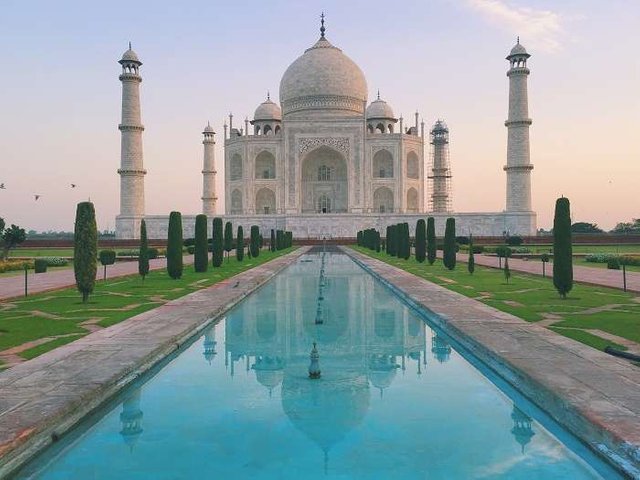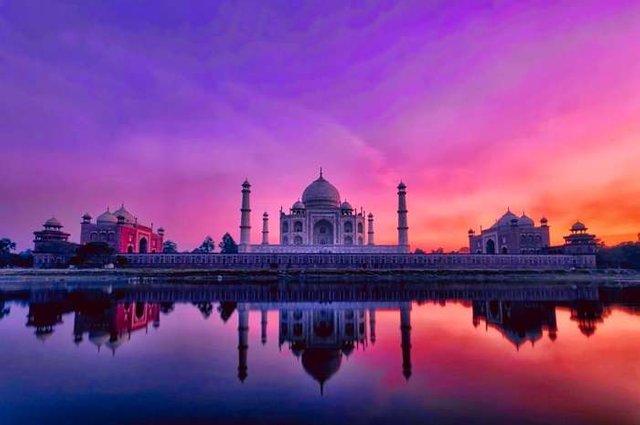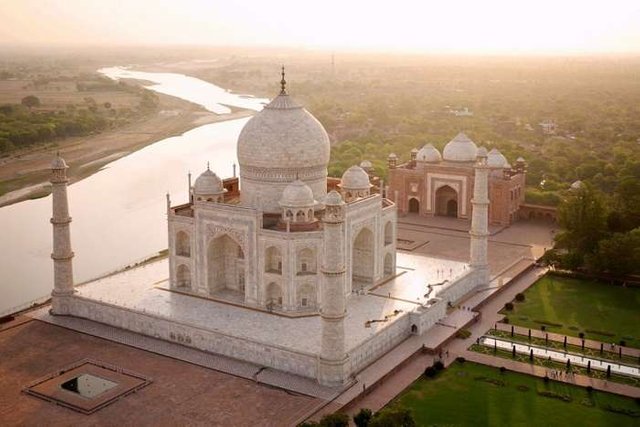
Famous as one of the wonders of the world, the Taj Mahal at Agra, India, is epitome of true love and passion. The Taj Mahal was built by the famous Mughal emperor Shah Jahan in memory of his beloved wife, Mumtaj Mahal. The architectural beauty and magnificence of the Taj Mahal has never been surpassed. It is said to be the most beautiful monument built by the Mughal rulers and represents the zenith of the Mughal architecture. Built entirely out of white marbles, the beauty of the Taj Mahal is beyond description. The beauty of the Taj Mahal has been aptly summarized by the famous English poet, Sir Edwin Arnold, as "Not a piece of architecture, as other buildings are, but the proud passions of an emperor's love wrought in living stones."
Architecture and Design
Taj Mahal, synonymous with India’s identity, is the crowning jewel of Mughal architecture in India. The Mughal tradition of erecting majestic mausoleums in memory of Royal members found its culmination in the Taj’s majestic form. The Humayun’s tomb built in 1562 was a major influence over Taj’s design. An architectural marvel, the structure incorporates elements of Persian influences like the design of the Dome and incorporation of arched entrances or ‘Iwans’ along with inspiration from contemporary Hindu design elements like chhatris and copious incorporation of the lotus motif. Described by Tagore as “the tear-drop on the cheek of time”, the monument embodies funereal austerity turned into the most beautiful reminder of eternal love.
Taj Mahal is part of an elaborate complex consisting of a decorative gateway, a beautifully designed garden, a wonderful water system and a mosque. The complex is situated on the southern banks of river Yamuna. The complex stretches in a south to north incline towards the river and is constructed in steps.

Exterior of the Taj Mahal
The central focus of the complex is the Tomb structure. Made completely out of white marble, its beauty lies in the symmetry of its architecture. The structure is situated on a raised square plinth, also made of white marble, at a height of 50 m from the river level, at one end of the complex. The tomb itself is situated at the center of the plinth, framed by four equidistant minarets. The Taj Mahal is a square structure with sides measuring 55 m. The minarets are spread at a distance of 41.75 m from the tomb wall and have a height of 39.62 m. There is a bulbous central dome in the main building, 18.28 m in diameter and 73 m in height. The dome is elevated from the top of the building by a 7 m high cylindrical base. It is decorated at its top by lotus motif and ends in a gilded finial topped with the Islamic half-moon. The spherical and grand aspect of the central dome is emphasized by incorporation of smaller domes on both sides in the form of chhatris, also capped in gilded finials. Each minaret is divided into three equal segments by two balconies and has an octagonal base. The delicate curve of the dome is emphasized by the tapering structure and slightly angular placement of the minarets. The entrance to the main tomb is framed by a huge arched vault or Iwan which in turn is again framed by two similar but smaller arches on each side. These arches indicate stacked balconies along two different levels. This is called pishtaqs, which is replicated on all the eight edges of the building affording it another dimension of symmetry.
The juxtaposition of solids and voids in combination with concave and convex design elements create a breathtaking effect of contrast. The marble exterior changes color periodically reflecting the light conditions of the day and produces an astonishing pearly diaphanous effect at night.
The exteriors of the Taj are inlaid with intricate decorations. Generously inlaid with precious gemstones like opals, lapis lazuli and jade, the decorations offer stunning flashes of color against a white background. Stucco and paintings cover the exterior walls along with calligraphy of verses from Quran or excerpts from poems in black marble. Murals of herringbone inlays and marble jaalis, mosaics of colored stones in geometric patterns along with abstract tessellations cover the exterior floors and surfaces.

The Garden (Mughal Garden) at the Taj Mahal
The garden is an intricate part of Mughal mausoleums and is commonly known as Charbagh. Raised red sandstone pathways divide the Mughal garden into four segments which are in turn fractioned into 16 symmetrical sections. A raised square marble pool is situated midway between the Taj Mahal and the Entrance. The Hawd al-Kawthar or Tank of Abundance positioned on the north-south axis offer beautiful reflection of the Taj in all its glory. Various fruit bearing trees and Cyprus trees symbolizing life and death respectively are arranged in symmetrical equidistant patterns along the raised central pathway. The garden is designed in such a way that it offers unhindered view of the Taj from any random point.
beautiful
Downvoting a post can decrease pending rewards and make it less visible. Common reasons:
Submit
thnks
Downvoting a post can decrease pending rewards and make it less visible. Common reasons:
Submit
Hi! I am a robot. I just upvoted you! I found similar content that readers might be interested in:
https://www.culturalindia.net/monuments/taj-mahal.html
Downvoting a post can decrease pending rewards and make it less visible. Common reasons:
Submit